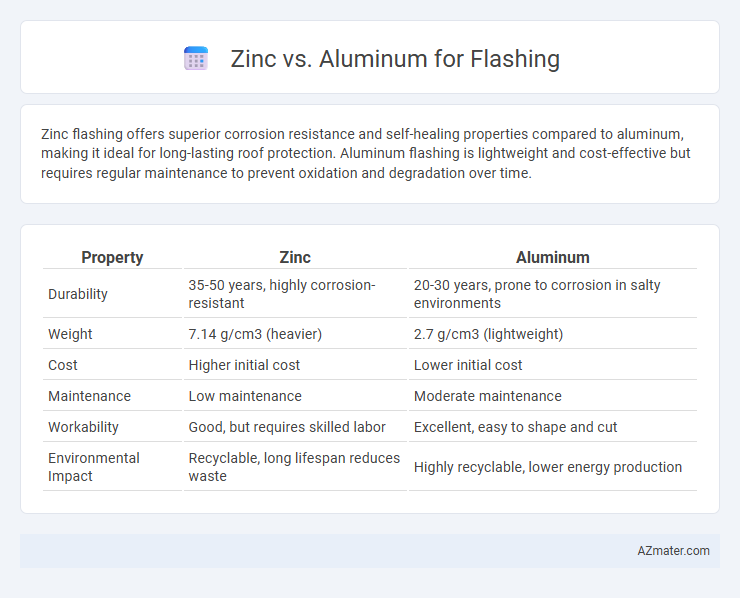Zinc flashing offers superior corrosion resistance and self-healing properties compared to aluminum, making it ideal for long-lasting roof protection. Aluminum flashing is lightweight and cost-effective but requires regular maintenance to prevent oxidation and degradation over time.
Table of Comparison
| Property | Zinc | Aluminum |
|---|---|---|
| Durability | 35-50 years, highly corrosion-resistant | 20-30 years, prone to corrosion in salty environments |
| Weight | 7.14 g/cm3 (heavier) | 2.7 g/cm3 (lightweight) |
| Cost | Higher initial cost | Lower initial cost |
| Maintenance | Low maintenance | Moderate maintenance |
| Workability | Good, but requires skilled labor | Excellent, easy to shape and cut |
| Environmental Impact | Recyclable, long lifespan reduces waste | Highly recyclable, lower energy production |
Introduction to Flashing Materials
Zinc and aluminum are two of the most popular materials used for flashing in roofing and construction due to their durability and corrosion resistance. Zinc offers a longer lifespan and self-healing properties, making it ideal for complex architectural designs, while aluminum is lightweight, easier to work with, and more cost-effective. Choosing between zinc and aluminum depends on factors such as budget, environmental conditions, and the specific demands of the project.
Key Properties of Zinc Flashing
Zinc flashing offers superior corrosion resistance and a natural self-healing patina that prolongs durability, making it ideal for long-term weatherproofing applications. Its flexibility and malleability allow for easy fabrication and seamless installation around complex roof shapes, enhancing waterproofing performance. Compared to aluminum, zinc provides better resistance to atmospheric pollutants and requires less maintenance, ensuring a longer lifespan in harsh environmental conditions.
Key Properties of Aluminum Flashing
Aluminum flashing offers excellent corrosion resistance due to its natural oxide layer, making it ideal for moist environments. Its lightweight nature and high malleability allow for easy installation and precise shaping around complex structures. Aluminum also boasts superior thermal conductivity, which helps in dissipating heat and preventing moisture buildup beneath roofing materials.
Durability: Zinc vs Aluminum
Zinc flashing offers superior durability compared to aluminum due to its natural corrosion resistance and ability to self-heal through patina formation, which extends its lifespan to over 80 years. Aluminum flashing, while lightweight and resistant to rust, is more prone to dents and environmental wear, typically lasting around 20 to 40 years depending on conditions. For long-term roofing projects requiring minimal maintenance, zinc is the preferred choice because of its enhanced strength and weather resilience.
Cost Comparison: Zinc vs Aluminum
Zinc flashing typically costs between $10 and $15 per square foot, making it more expensive than aluminum flashing, which ranges from $5 to $8 per square foot. The higher price of zinc reflects its durability and corrosion resistance, resulting in lower maintenance expenses over time. Aluminum flashing is more budget-friendly upfront but may require more frequent replacement in harsh environments.
Weather Resistance and Corrosion
Zinc flashing offers superior weather resistance due to its self-healing patina, which continuously protects against corrosion in diverse climates. Aluminum flashing, while lightweight and affordable, is prone to corrosion and degradation when exposed to acidic rain or salty environments without proper coatings. Zinc's long lifespan and durability make it the preferred choice for harsh weather conditions and extended corrosion resistance.
Installation Process Differences
Zinc flashing requires precise handling due to its malleability and susceptibility to scratching, often necessitating specialized tools and techniques such as soft soldering for seals. Aluminum flashing is lighter and easier to cut and shape with standard tools, facilitating quicker installation but may require additional sealants to prevent corrosion where joints occur. Zinc's natural patina provides long-term protection with less maintenance, while aluminum needs anodizing or coating to enhance durability against weathering during installation.
Environmental Impact and Sustainability
Zinc flashing offers superior environmental benefits due to its longevity and high recyclability, reducing waste over time compared to aluminum. Aluminum production is energy-intensive and associated with higher carbon emissions, while zinc's natural corrosion resistance minimizes maintenance and replacement needs. Selecting zinc flashing supports sustainable construction by lowering the overall environmental footprint and promoting resource conservation.
Maintenance Requirements
Zinc flashing requires minimal maintenance due to its natural patina that self-heals and resists corrosion, reducing the need for frequent inspections or repairs. Aluminum flashing, while lightweight and easy to install, may require more regular upkeep since it is prone to oxidation and potential corrosion, especially in coastal or acidic environments. Proper sealing and periodic cleaning can extend the lifespan of aluminum flashing, but it generally demands higher maintenance compared to zinc.
Which Flashing Material is Best for Your Project?
Zinc flashing offers exceptional durability and corrosion resistance, making it ideal for long-lasting, low-maintenance roofing projects, especially in coastal or acidic environments. Aluminum flashing provides a lightweight and cost-effective option with good flexibility and ease of installation, suited for residential roofs with moderate exposure to weathering. Choosing between zinc and aluminum depends on project requirements such as budget, environmental conditions, and desired lifespan, with zinc preferred for longevity and aluminum favored for affordability and ease of use.

Infographic: Zinc vs Aluminum for Flashing
 azmater.com
azmater.com